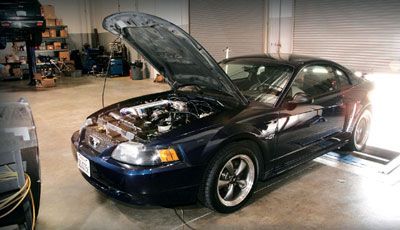
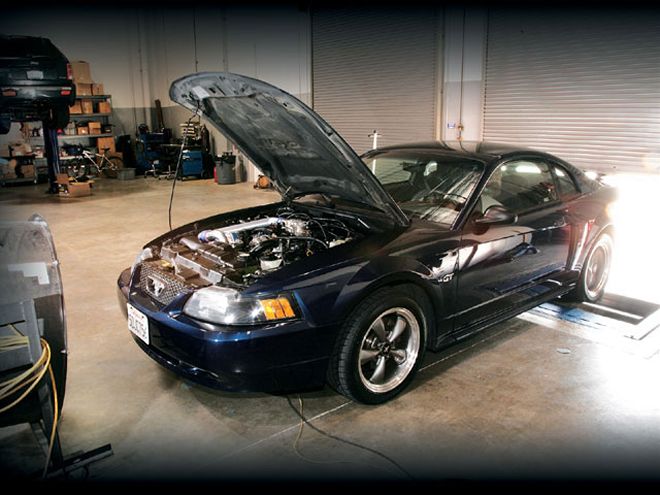
It's hard for us to compete with the new cars being deployed out of Detroit these days. The Corvettes come with 400 hp for the base model, and the ponies like the Mustang, Pontiac G8, and soon-to-be Challenger R/T come with over 300 hp. With money tight in these tough times, we can't all go buy a new high-tech hot rod off the showroom floor, but that doesn't mean we can't compete. We just need to dig deeper into our bag of bolt-ons.
Options for adding horsepower are to install some sort of power adder (including cam, heads, and intake for the sake of argument). The choice depends on how involved you want to get with the installation, and your budget. Nitrous is a cheap, easy way to make horsepower, but its short-lived blasts of acceleration leave much to be desired. Turbochargers are very efficient, and yield impressive power gains, but installation requires fabrication that not everyone has the equipment to do on their own. But there is one option that has an easy installation process, a ton of power, and can be done on a reasonable budget-a supercharger.
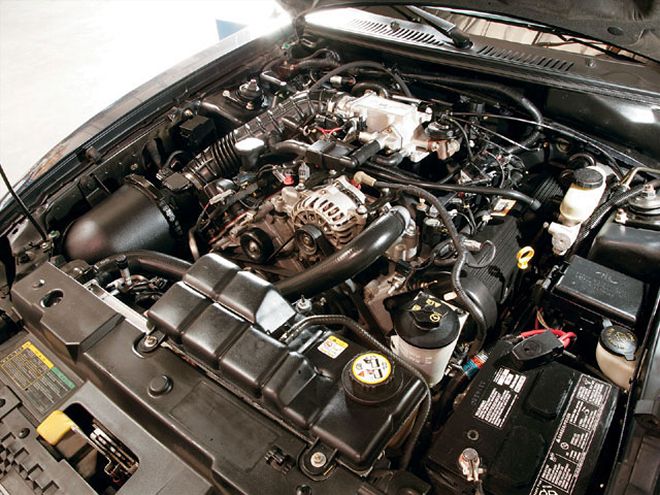 There is a lot going on in here; it's hard to imagine that a supercharger will fit with room to spare.
There is a lot going on in here; it's hard to imagine that a supercharger will fit with room to spare.
Superchargers come in two basic types: positive displacement and dynamic. An example of a positive-displacement supercharger is a Roots type. These can be found on many OEM applications. The downfall of these is that they require removal of the intake manifold, which must be replaced with a generally taller unit. Modern cars don't come with much spare room in the engine bay, so something that leaves us with hood clearance is necessary. A centrifugal supercharger falls under the dynamic supercharger category. They look and work more like a turbocharger; the major difference is that rather than being driven by exhaust gasses, it uses a belt, chain, or gear attached to the crankshaft.
Vortech makes a supercharger kit for our daily-driver 2003 Mustang GT test mule that includes everything you need. For those living in California and other smog-governed states, do not fear, this kit comes with a 50-state smog-legal certification. This kit is mild-mannered enough to be run on a high-mileage motor like ours, which had 103,000 miles. There was speculation on our part as to how the automatic transmission would react to this power boost, or even if it would hold up, but it fared well and has not shown any sign of failure.
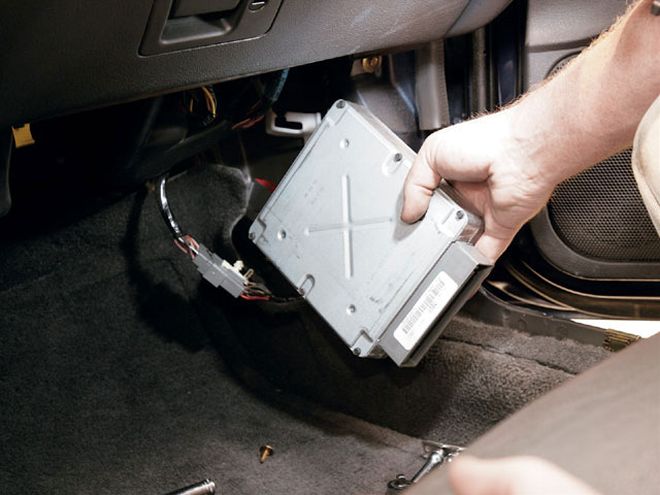 You need to let the boss know what's going on-and in this case, the computer is the boss. Here, you can see the computer being removed from the passenger-side kick panel. Vortech has a lightning-fast reprogramming turnaround time that won't leave you hanging.
You need to let the boss know what's going on-and in this case, the computer is the boss. Here, you can see the computer being removed from the passenger-side kick panel. Vortech has a lightning-fast reprogramming turnaround time that won't leave you hanging.
We were lucky enough to get the first taste of Vortech's V3-Si model supercharger, which is based on the earlier V-2. Its redesign gave it 5 percent greater efficiency over the V-2's already impressive 72 percent, and adds to that equation an extremely user-friendly self-contained oiling system. Most kits on the market call for oil to be plumbed from the engine to the supercharger by means of a fitting in the oil pan. Also, the improvement in the V3-Si's compressor efficiency let us achieve 9 psi boost at 6,000 rpm. This revised unit therefore requires a different fuel map and mass air transfer function to take full advantage of the extra power potential.
InstallationThe first step you'll need to do after ordering your Mustang kit is to remove the car's computer and have it sent to Vortech to be reprogrammed. Modern cars are controlled by computers that use sensors to read what the car is doing. Unfortunately, these units cannot read what has physically been changed to the engine. For example, the fuel injectors are opened for a duration specified by the computer. If the flow of the injectors changes with the same open duration, they will allow more fuel than intended. This is why it's important to have the computer reprogrammed to accommodate the changes made to the engine.
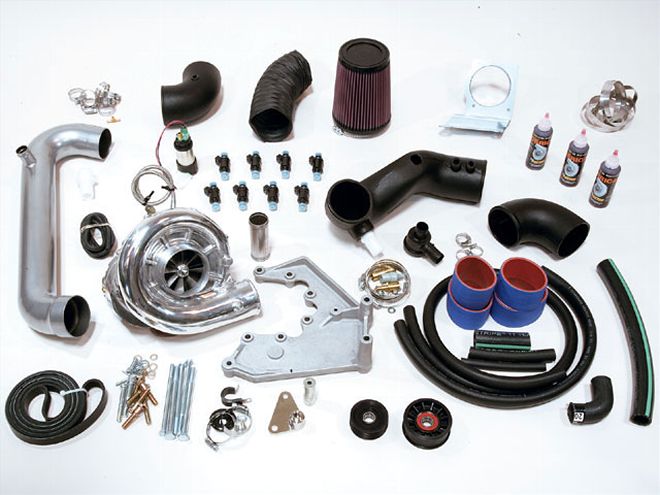 Everything you need comes in this kit: injectors, hose clamps, belt, plumbing, and the supercharger itself. The suggested retail price for the '03 Mustang GT kit tested here: $4,257.95 (PN 4FL218-138SQ). The street price from mail-order specialist Summit is $3,811.95.
Everything you need comes in this kit: injectors, hose clamps, belt, plumbing, and the supercharger itself. The suggested retail price for the '03 Mustang GT kit tested here: $4,257.95 (PN 4FL218-138SQ). The street price from mail-order specialist Summit is $3,811.95.
Because the supercharger adds air, adding fuel is necessary to optimize the power gain and keep the air/fuel mixture from going lean. Replacing the fuel pump is the hardest part of the installation because Ford uses an in-tank pump that requires you to drop the tank, pull the sump unit out, and replace the pump. If you're like most people, you won't have your own personal lift like we did. Fortunately, this job can be done without one.
The engine compartment only needs minor changes to accommodate the new blower. Since a pulley is being added to the front of the engine, the idler and belt position will be changed. Vortech includes a replacement idler and bracket to allow the correct placement and rotation of the supercharger. The belt used is the same rib thickness as the factory, just in a different length. That way, no pulleys will have to be replaced.
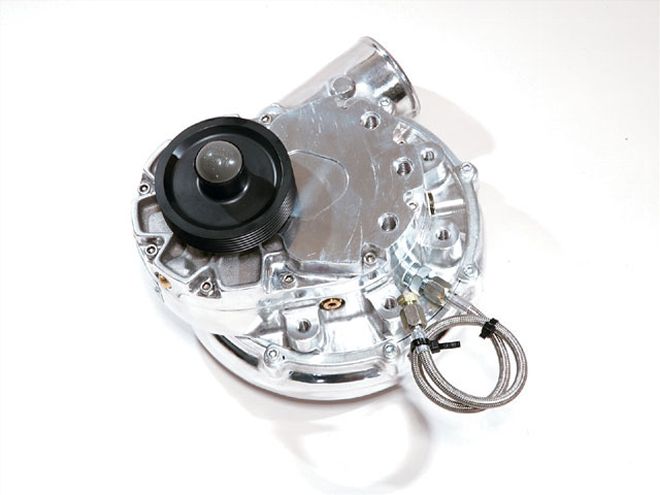 Many superchargers use an external oil feed line that requires the oil pan to be drilled and tapped for the return. This kit, however, features a self-contained oiling system that has a single line used as a drain.
Many superchargers use an external oil feed line that requires the oil pan to be drilled and tapped for the return. This kit, however, features a self-contained oiling system that has a single line used as a drain.
Fabrication plays a very light hand in this job. The factory air-conditioning line needs to be bent to allow clearance for the inlet port of the supercharger. Luckily, this line is made from malleable aluminum tubing, and can be bent by hand quite easily. In the kit, you will find a radiator-hose extension tube that moves the hose closer to the radiator in order for it to clear the supercharger.
The air filter is relocated behind the fender like many aftermarket intake systems. The plumbing is fairly straightforward: a tube from the inner fender leads directly to the supercharger. When the throttle is closed, pressurized air is still being produced for a moment. This unwanted charge pressure needs to be vented to avoid excess pressure on the supercharger's internals. A valve located in the intake tube directs this air back through the inlet of the supercharger and is recirculated until the throttle is open again.
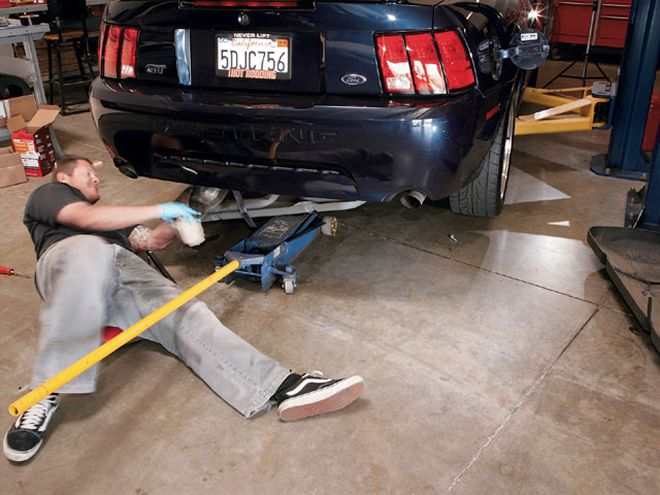 Ricky Best, media relations manager at Vortech, helped us with the install. Here, he is dropping the fuel tank to remove the fuel pump assembly. This step was the only source of grief, due to heavy, awkward parts.
Ricky Best, media relations manager at Vortech, helped us with the install. Here, he is dropping the fuel tank to remove the fuel pump assembly. This step was the only source of grief, due to heavy, awkward parts.
Testing And TuningThe Mustang's baseline dyno test showed us that there was definitely room for improvement. With 182 hp to the rear wheels, the Mustang's power-to-weight ratio was 2 pounds per horsepower higher than a Honda Accord. That was sure to change. Since installing the supercharger, peak horsepower moved from 182 to 246, and torque from 195 to 257. The biggest change was not at peak, but showed up in the higher power range. When it comes to racing, whether it be on the road course or the strip, this is where the engine lives. At some points in the powerband, such as at 6,000 rpm, the supercharger showed as much as a 100hp improvement. Although the final dyno numbers are not groundbreaking, the improvements are. To give you an idea of what this power will do for you, based on a calculation of curb weight and rear-wheel horsepower, a stock automatic Mustang GT will run a 15.4-second quarter-mile time. With the supercharger, that time drops to 13.77 seconds, so you better get a helmet!
On The StreetAfter the key turns, the distinct blower sound catches your attention. This whine is recognized by car enthusiasts of all ages as the sound of power. The change in low-rpm grunt is obvious right away, followed by an even larger charge at the top end. Despite the extra 100 hp, and commensurate climb in torque, the car's driveability was unchanged. There was no surging or overheating-phenomena commonly linked to supercharged cars. From afar, with its stock body and whisper-quiet exhaust, the Mustang seemed stock-prey to almost any later-model V-8 ride, but make no mistake, this was no longer your everyday Mustang.
Still Not Enough?Want to make even more power? One of the major limiting factors of how much you can gain from your supercharger is the heat they produce. It is a byproduct of physics that when air is compressed, heat is created. To get this heat out of the incoming air, an aftercooler is needed. Vortech makes a supplemental kit for the blower installed here that integrates an air-to-water charge cooler. The system resembles that of a car's cooling system with a finned heat exchanger, water pump, and water tank. The ambient air passes through the heat exchanger, which is installed on the radiator support. The cooled water moves into the aftercooler, removing some of the heat created by the blower. With the cooler intake charge, the engine can handle a higher boost pressure from the supercharger. This, like the initial installation, calls for a computer recalibration. The aftercooler kit can be purchased at the same time as the supercharger kit, and a $1,000 savings is realized over the standalone price.
Big TipYou'll save yourself a lot of time down the road if you read the installation manual prior to starting. That way, you'll know exactly what to expect throughout the installation. You'll also know what needs to be done prior to installing the system. In this specific case, there is a note that tells you that one of the very first things to be done is to remove the computer and place it in the supplied UPS prepaid overnight shipping package. This package is preaddressed to Vortech, and will arrive at Vortech no later than 10:00 a.m. the day after shipping. Vortech usually turns them around that same day, or in the worst case, the next day.
Camaros & Firebirds Too!Vortech offers similar kits to cover all third- and fourth-generation Camaros and Firebirds. All of these kits come in entry-level (standard output) and high-output (with aftercooler) versions, with the exception of the '88-92 kits. As with the Mustang kit, you can save money by ordering the aftercooler kit initially, if that is in your game plan. Most of these kits come in satin, as well as polished.
APPLICATION: PN: MSRP: LS1 '99-02 Camaro/Firebird standard system 4GK218-010SQ $5,623.95 '98-00 Camaro/Firebird with aftercooler 4GK218-060SQ $6,695.95 '01-02 Camaro/Firebird with aftercooler 4GK218-080SQ $6,695.95 LT1 '93 Camaro/Firebird standard system 4GH218-050SQ $4,655.95 '93 Camaro/Firebird with aftercooler 4GH218-050SQ $5,995.95 '94-97 Camaro/Firebird standard system 4GH218-060SQ $4,498.95 '94-97 Camaro/Firebird with aftercooler 4GH218-090SQ $5,895.95 TPI '88-92 Camaro/Firebird standard system 4GF218-060SQ $4,025.95